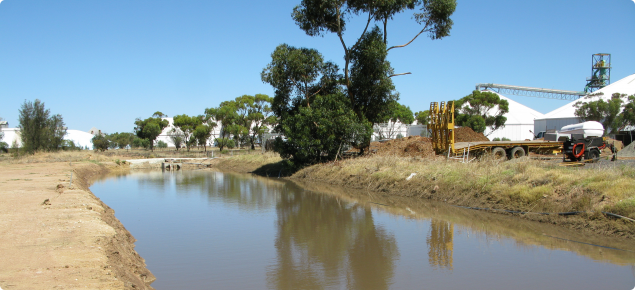Project overview
DAFWA, with partner Wheatbelt NRM, provided resources to regional local government authorities to plan and implement best practice stormwater management infrastructure in wheatbelt towns.
DAFWA led the project based on its experience and expertise in assisting regional towns to use locally sourced water, such as through the Rural Towns Program. Wheatbelt NRM coordinated delivery of the project and wrote the final report.
Many rural communities are faced with an annual dilemma — they cannot afford to use expensive, drinking-quality scheme water for irrigation over summer, nor do they want to allow their well-utilised and highly valued community sports grounds to die.
The community and environment benefit by harvesting stormwater, and using this resource to keep public open spaces irrigated, and to reduce the use of drinking-quality water supplies.
Climate projections for the south-west of Western australia are for higher temperatures and lower rainfall. Wheatbelt towns will suffer from those conditions, and will need improved water management to maintain their communities. Stormwater reuse is one strategy to provide an efficient, reliable and safe water supply for communal use.
What is stormwater harvesting?
Stormwater harvesting is the collection and reuse of runoff from urban areas that would otherwise end up in natural drainage systems. While the approach to stormwater harvesting differs between locations, the elements include:
- collection of rainwater from roofs, hardstands, sports areas, road surfaces, town drains or creeklines
- temporary storage of runoff water in excavated sumps or tanks (above or below ground)
- water transfer to larger storage units, a process known as 'bulking up'
- passive infiltration or injection of stormwater into a suitable groundwater aquifer (this option is limited by the site)
- reticulation to distribution locations, most commonly irrigation points or to a standpipe.
An example of an effective stormwater harvesting and reuse scheme is in the town of Wagin. DAFWA has helped the Shire of Wagin design and implement a whole townsite water management scheme for water conservation and salinity control. Stormwater capture and reuse is an important component of that scheme.
In places like Wagin affected by salinity, rising groundwater and waterlogging in the townsite is being managed with a comprehensive borefield installed to dewater the local aquifer. The shire is also capturing most of its stormwater and much of the town catchment runoff with a 6000 cubic metre weir across one of the main town drains. The high quality surface water is then pumped back up-slope to the 25 000 cubic metre ‘Brown’ dam (see photo below), from which the town sports oval and other recreational sites are irrigated.
Stormwater reuse can convert townsite runoff, that may be considered a nuisance or threat, into a productive resource that sustains a community’s wellbeing by maintaining a sports ground that is a source of local identity and pride.

